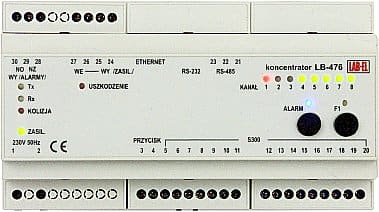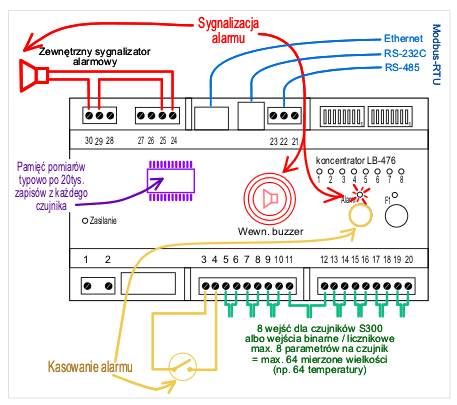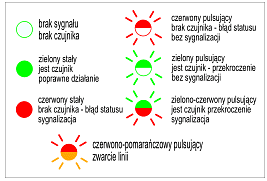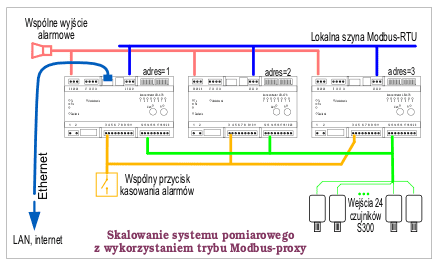- 8 channels: sensors S300,
binary inputs
- 1 counter input
- Modbus-RTU
communication
- isolated interfaces: RS-232C, RS-485, Ethernet
- measurement memory: over 20
thousand records for each sensor in a typical configuration
- alarming

|
 |
Concentrator LB-476 is designed for cooperation with
the LAB-EL sensors equipped with an interface S300, using which
the device provides power supply and communicates with the sensors. It
is possible to serve up to 8 sensors S300. Alternatively, each-one of
the inputs can be used for connecting a two value signal (short circuit
input). One of the inputs, in a binary mode, works additionally as an
input counting the impulses (designed for attaching to a
rain-gauge).
 Data
sent through the sensors is buffered in the concentrator’s operational
memory and made available as the registries of a Modbus-RTU data bus.
In each channel 8 measured values are served, what allows on
supervision of over maximum 64 measurements (i.e. 64 temperatures when
connecting 8 sensors type LB-711).
Data
sent through the sensors is buffered in the concentrator’s operational
memory and made available as the registries of a Modbus-RTU data bus.
In each channel 8 measured values are served, what allows on
supervision of over maximum 64 measurements (i.e. 64 temperatures when
connecting 8 sensors type LB-711).
For each measured value it is possible to define a set of the alarm parameters, including: upper and lower alarm threshold, a delay in alarm functioning, time of alarm postponing. A concentrator user can temporarily block alarm signaling (postpone), or make the appearing alarms to be confirmed by pressing a key button. For signaling an inside buzzer is used, a LED control and optionally an outside signaler. Internal and external signalization have separately defined: alarm activity and delay. There is also an input (short circuit) for the outside key button that doubles the key button function alarm.
The concentrator LB-476 conducts registry of the received measurement data. Each served measurement value can be stored to a registry every specified time, an average value determined by the period between the entries can also be stored, just as well as a minimum and maximum value, value dispersion of indications, or a combination of the mentioned above options: (a) an average and a dispersion of indications (b) an average, minimum and maximum. The dispersion is here understood as a difference between the maximum and minimum values. The entries interval (repeat time) is set in the scope from 0 to twenty four hours with 1 minute resolution. The registry can be performed in a constant mode, when the newest data overwrite the older entries, and in a mode with the entries blocking after the data space is filled. The registry is organized as 124 data files of constant size 4kB. The files’ content is possible for readout using an interface and a Modbus-RTU protocol. The readout and decoding is performed by a dedicated program. The maximum number of entries that can be contained in the registry depends on the registry configuration i.e. when storing the average temperature and humidity values of (hytherograph LB-710) in eight channels it is possible to store over 20 thousand records (for each sensor), what results in registry for 2 weeks with registry every 1 minute (and adequately longer when delaying an entry interval).
 The device has a number of
LED lighting controls that signal correctness of work or errors: (a)
with each channel a two color lighting control is associated signaling
the following statuses: correct work, short-circuit line, exceeding an
alarm threshold and an error of a measured parameter (see picture on
the right), (b) a blue lighting control Alarm signals the
exceeds (c) a red lightning control Failure signals an alarm
status caused by a device problem (i.e. line short-circuit, clock
error), (d) the lightning controls Tx/Rx flash when
sending communicates between a concentrator and terring software; (e)
an additional lightning control F1 and a key button F1 are fully
controlled by a user software (available as Modbus records) and can be
used for any purposes.
The device has a number of
LED lighting controls that signal correctness of work or errors: (a)
with each channel a two color lighting control is associated signaling
the following statuses: correct work, short-circuit line, exceeding an
alarm threshold and an error of a measured parameter (see picture on
the right), (b) a blue lighting control Alarm signals the
exceeds (c) a red lightning control Failure signals an alarm
status caused by a device problem (i.e. line short-circuit, clock
error), (d) the lightning controls Tx/Rx flash when
sending communicates between a concentrator and terring software; (e)
an additional lightning control F1 and a key button F1 are fully
controlled by a user software (available as Modbus records) and can be
used for any purposes.
Communication with the device is performed by using a series port RS-232C or RS-485 or a LAN network. The concentrator supports data exchange using the communicates Modbus-RTU. When using a port RS-485 it is possible to attach LB-476 to existing bus rail Modbus with many devices. The bus rail’s address is set with the switches in the scope 1..31. The device supports various character formats and transmission speed. The device has a built-in line terminators RS-485 switched on by the switches. When communicating using a LAN network, an interface Ethernet is used (dla LB-476E). The concentrator can be seen in an internet network as a TCP served. Simultaneously it is possible to use only one type of interface except from a mode Modbus-proxy described later on.

A special communication mode was provided for a situation, in which
a user needs to attach a greater number sensors. System scaling is
possible after put together many concentrators LB-476, using only one
Ethernet interface, where a concentrator is equipped with a LAN
interface works as a Modbus-proxy assuring LAN packet conversion to a
local Modbus-RTU for the rest of the concentrators. All concentrators
also have a common alarm output and a common alarm deletion key button.
| Power supply |
|
|---|---|
| network power supply |
230V 50 Hz |
| emergency power supply | 12V DC |
| energy consumption | 6 VA |
| Alarm output, power supply output | |
|---|---|
| outside output alarm load carrying capacity |
230V / 50Hz / 1A |
| type of load carrying capacity |
resistance |
| power supply output | 16-20V DC / 100mA |
| Recommended constant work conditions | |
|---|---|
| scope of temperatures |
0..50C |
| scope of humidity | 20..80% |
| level of environment corrosion aggressiveness according toPN-71/H-04651 | B |
| class of resistance according to DIN40050 | IP40 |
| Memory interfaces S300 | |
|---|---|
| signal |
current, switch-over threshold 20mA, max 25mA |
| sign format |
300 7N1 |
| sensors powering | 12.5-14.0V DC |
| Measurement interfaces: binary outputs (a) | |
|---|---|
| signal |
current signal, exceed threshold 20mA, max 25mA |
| power supply |
12.5-14.0V DC |
| Measurement interfaces: binary outputs (b) | |
|---|---|
| signal |
short circuit switch |
When using a channel as a binary input (short circuit) it is necessary to: (a) fix in a circuit two resistors according to a description in the instruction or alternatively (b) stating in an order the number of binary inputs, then a user is going to receive a concentrator with hardware configured short circuits inputs, without a need of applying the outside elements. When choosing the solution (b) using the binary inputs is not going to be possible in order to attach the sensors S300.
| Measurement interface: counter input | |
|---|---|
| scope if counting |
0 ... 16777215 (224-1) |
| minimum interval between the impulses | 500 ms |
A counter input is active on the last concentrator channel, after setting sensor type to a binary input. A value counted is stored in a non-volatile memory.
| Communication interface RS-232C, RS-485 | |
|---|---|
| sign format |
8E1, 8N2/8N1 |
| transmission speed | 2400, 9600, 19200, 38400 bps |
| isolation | 1.5 kV |
| protocol | Modbus-RTU |
Format 8N2/8N1 denotes that a provided character has a format 8N2 but when received also 8N1 is accepted what provides flexibility when setting common parameters for various types of the devices or a common bus rail.
| Communication interface LAN | |
|---|---|
| medium | ethernet |
| transmission speed | 10, 100 Mbps (autosensing) |
| isolation | 1.5 kV |
| protocol | Modbus-RTU na TCP |
It works as a server TCP serving data stream formatted identically as for the packets Modbus-RTU. The interface has a configured address IP and a port TCP.